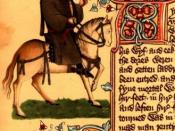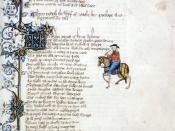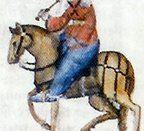During the late Middle Ages, the majority of society deemed women as inferior to men. In Geoffrey Chaucer's The Canterbury Tales, the Wife of Bath represents a nontraditional role for women of that time. A woman's role customarily did not include a voice in society, religion, or government. The Wife of Bath's history includes five marriages, numerous lovers, and three trips to Jerusalem. The Wife of Bath's character steps outside tradition in both the physical and the psychological aspects, emerges as a heroine for women, but surfaces as a villain for men.
Physically, the Wife of Bath may have grown unattractive over time but her physical appearance represents her prosperity and experience. During her youth, she most likely represented a satisfactory catch for a wife. Being a plump woman with expensive, stylish clothes indicates that she descends from a wealthy background and married into prosperity. Even without her sexually boastful tone, the Wife of Bath's scarlet stockings represent the strong sensual desire within her five marriages and other numerous relations with men.
Chaucer described her with large hips and an equally large hat meaning she fulfills the role of mother yet remains elegant in style. Her boisterous manner should be a sign that most men would not find her desirable but her history of affairs says otherwise.
The Wife of Bath clearly uses her wit and wisdom to secure happiness in her marriage by keeping her husband submissive. Her ability to effectively maintain control over her husbands and lovers enables the Wife of Bath to be a loyal and faithful spouse, which she demonstrates is what a man truly desires. Psychologically, she surpasses her husbands, intimate companions, and most men she encounters. The Wife of Bath successfully strengthens her arguments with knowledge of scripture and her logical line...


